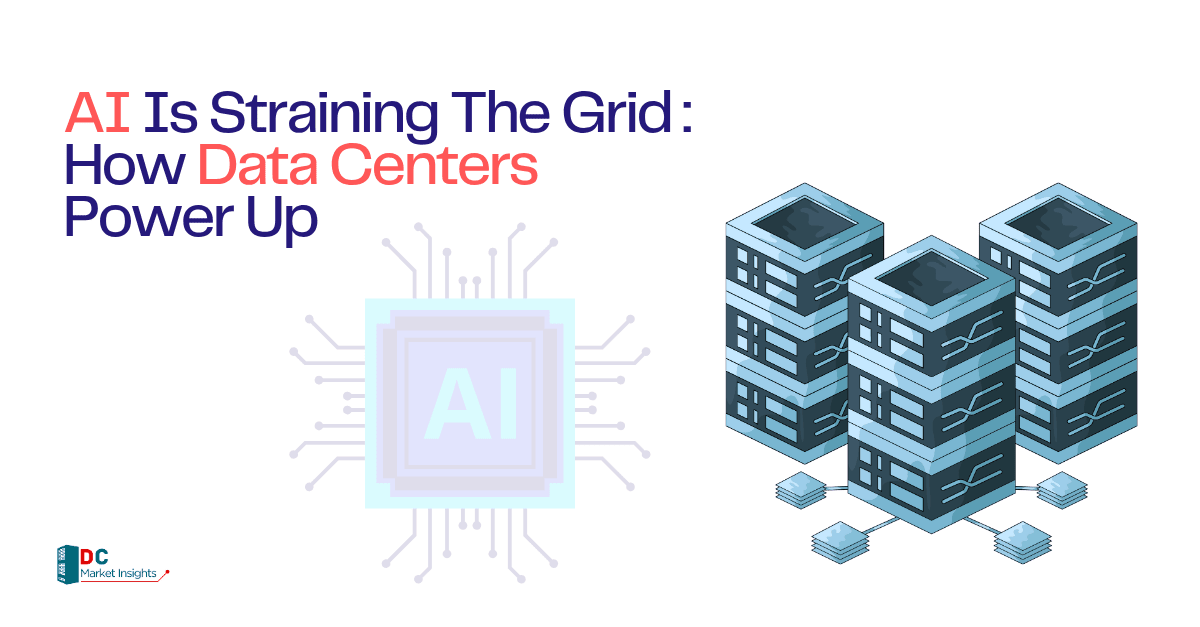The artificial intelligence revolution is consuming electricity at an unprecedented rate, and the infrastructure supporting it is approaching a breaking point. As ChatGPT, Gemini, and countless other AI models train on massive datasets and process billions of queries daily, data centers—the physical backbone of this digital transformation are projected to account for up to 9% of total U.S. electricity demand by 2030, nearly triple their current consumption. This surge comes at a critical moment when power grids across North America, Europe, and Asia are already strained by extreme weather events, aging infrastructure, and the transition to renewable energy sources.
The collision between AI’s insatiable appetite for computing power and the grid’s limited capacity has created an urgent dilemma: either the AI boom stalls due to insufficient electricity, or data center operators pioneer innovative solutions to generate, store, and optimize their own power. The answer lies in a fundamental reshaping of how these massive facilities source their energy, from on-site renewable installations and advanced battery systems to strategic grid partnerships and next-generation cooling technologies that reduce overall consumption.
Why AI is different from cloud
Artificial intelligence (AI) and cloud computing are distinct technologies that serve different purposes, though they are often used together. AI is a field focused on creating intelligent systems that can perform tasks that typically require human intelligence, while cloud computing provides on-demand access to computing resources over the internet.
The primary difference lies in their function: AI analyzes data to provide insights and automate processes, whereas the cloud provides the foundational infrastructure, such as storage and processing power, to run applications and manage data.
|
Feature | Artificial Intelligence (AI) | Cloud Computing |
|
Primary Goal |
To build intelligent systems that simulate human cognitive functions like learning, decision-making, and problem-solving |
To provide scalable, on-demand access to shared computing resources like servers, storage, networking, and software over the internet |
|
Core Function |
Analyzes data, recognizes patterns, makes predictions, and automates tasks . It uses computing power to process data and train complex models . |
Manages and stores large volumes of data, hosts applications, and provides the raw processing power needed for various tasks, including AI |
|
Common Use Cases |
Predictive analytics, fraud detection, customer service automation, computer vision, and personalized marketing . |
Data storage, web hosting, disaster recovery, application hosting, and software development . |
The Synergy Between AI and the Cloud
Artificial intelligence (AI) and cloud computing are not competing technologies but are instead deeply intertwined in a symbiotic relationship. Each technology significantly enhances the capabilities of the other, creating a powerful combination that drives innovation across industries. The cloud provides the essential infrastructure for AI to operate at scale, while AI brings intelligence to optimize and secure cloud environments.
Cloud Computing as the Bedrock for AI
The massive computational power and vast data storage required to develop, train, and deploy complex AI models are provided by cloud platforms. The cloud serves as the foundational layer that makes large-scale AI both feasible and economically viable for a wide range of organizations.
- Vast Computational Resources: AI, particularly deep learning, relies on processing immense datasets through complex algorithms, a task that demands significant computational power often delivered by specialized hardware like Graphics Processing Units (GPUs) and Tensor Processing Units (TPUs). Cloud providers such as Amazon Web Services (AWS), Microsoft Azure, and Google Cloud offer on-demand access to this powerful infrastructure, allowing organizations to train models without the prohibitive capital investment in on-premise hardware.
- Scalable Data Storage and Management: AI models are data-hungry, requiring enormous volumes of information for training and validation. Cloud services provide virtually limitless, cost-effective, and durable storage solutions, such as Amazon S3 or Google Cloud Storage, capable of handling petabytes of data. This allows businesses to aggregate and process the extensive datasets necessary for building accurate predictive models.
- Democratization and Scalability: By removing the need for upfront hardware investment, the pay-as-you-go model of cloud computing has democratized AI. Startups, research institutions, and individual developers can access the same cutting-edge resources as large enterprises. Furthermore, the cloud’s elasticity allows users to scale resources up for intensive training jobs and scale back down for inference, ensuring optimal resource utilization and cost-efficiency.
- Managed AI Platforms: Leading cloud providers offer integrated, end-to-end Machine Learning (ML) platforms like Amazon SageMaker, Google Vertex AI, and Azure Machine Learning. These services streamline the entire ML lifecycle, from data labeling and preparation to model building, training, deployment, and monitoring. For instance, companies use these platforms to accelerate the development of applications ranging from personalized customer recommendations to fraud detection systems.
AI Enhancing Cloud Services
While the cloud enables AI, AI, in turn, makes cloud computing smarter, more efficient, and more secure. AI algorithms are increasingly integrated into the core of cloud services to automate management, optimize performance, and bolster security protocols.
- Automated and Intelligent Operations (AIOps): AI is used to automate the management and optimization of cloud infrastructure. AIOps platforms continuously monitor systems, analyze performance metrics, and predict potential issues before they cause downtime. These systems can automatically adjust resource allocation, manage workloads, and perform self-healing actions to maintain system health and reliability, significantly reducing the need for manual intervention.
- Cost Optimization and Resource Management: AI algorithms analyze cloud usage patterns to identify inefficiencies and provide actionable recommendations for cost savings. For example, AI can pinpoint underutilized virtual machines, suggest more cost-effective resource configurations (a process known as “rightsizing”), or advise on purchasing reserved instances for predictable workloads, helping organizations control and reduce their cloud expenditure.
- Advanced Security and Threat Detection: In the realm of cybersecurity, AI is a critical tool for protecting cloud environments. AI-powered security systems can analyze billions of events in real time across networks and applications to detect anomalies and identify sophisticated threats that might evade traditional rule-based security measures. For instance, AI can recognize unusual data access patterns or network traffic that may indicate a security breach, enabling a faster and more effective response.
Cloud AI vs. Edge AI
The primary distinction between Cloud AI and Edge AI lies in where the data processing and AI computations occur. Cloud AI leverages centralized cloud data centers, while Edge AI performs computations locally on or near the device where the data is generated. Each approach offers distinct advantages and is suited for different applications.
Cloud AI
Cloud AI involves sending data from a device to a remote, centralized cloud server for processing. These cloud environments are equipped with immense computational power and vast storage capabilities, making them the ideal platform for resource-intensive AI tasks. All the heavy lifting, such as training complex machine learning models or analyzing massive datasets, happens in the data center. The results are then sent back to the end-user device. This model is highly effective for applications that are not time-sensitive but require significant processing muscle.
- Key Characteristics: It relies on a stable internet connection to transfer data to and from the cloud. The centralized nature allows for the aggregation of data from numerous sources, which can improve model accuracy over time.
- Ideal Use Cases: This approach is well-suited for training large-scale language models, performing complex big data analytics, powering recommendation engines for e-commerce, and conducting scientific simulations. For instance, a natural language processing service that translates entire documents relies on cloud AI to handle the complex computations.
Edge AI
In the Edge AI model, AI algorithms run directly on local hardware at the “edge” of the network. This could be a smartphone, an Internet of Things (IoT) sensor, a smart camera, or within a vehicle’s onboard computer. By processing data locally, Edge AI avoids the round-trip journey to a distant cloud server. This approach is critical for applications where speed, privacy, and operational continuity are paramount.
- Key Characteristics: Edge AI significantly reduces latency, enabling real-time decision-making. It also enhances data privacy and security because sensitive information can be processed and stored locally without being transmitted over the network. Furthermore, it allows applications to function even with intermittent or no internet connectivity.
- Ideal Use Cases: This model is essential for autonomous vehicles that must make split-second decisions, wearable health monitors that analyze biometric data in real time, smart manufacturing systems that detect product defects on the assembly line, and retail stores using cameras for real-time inventory tracking.
Cloud AI vs. Edge AI
|
Feature |
Cloud AI |
Edge AI |
|
Processing Location |
Centralized cloud servers and data centers. |
Locally on the end device or a nearby server. |
|
Latency |
Higher, due to data transmission to and from the cloud. |
Very low, enabling real-time responses. |
|
Connectivity |
Requires a constant and stable internet connection. |
Can operate offline or with intermittent connectivity. |
|
Data Privacy |
Data is sent to a third-party cloud, raising potential privacy concerns. |
Data is processed locally, offering enhanced privacy and security. |
|
Scalability & Power |
Virtually unlimited computational power and storage. |
Limited by the hardware capabilities of the edge device. |
|
Cost |
Involves ongoing costs for cloud services and data transmission. |
Higher initial hardware cost but lower data transmission costs. |
|
Best For |
Large-scale model training, big data analytics, and non-real-time tasks. |
Real-time applications, low-latency requirements, and enhanced data privacy. |

